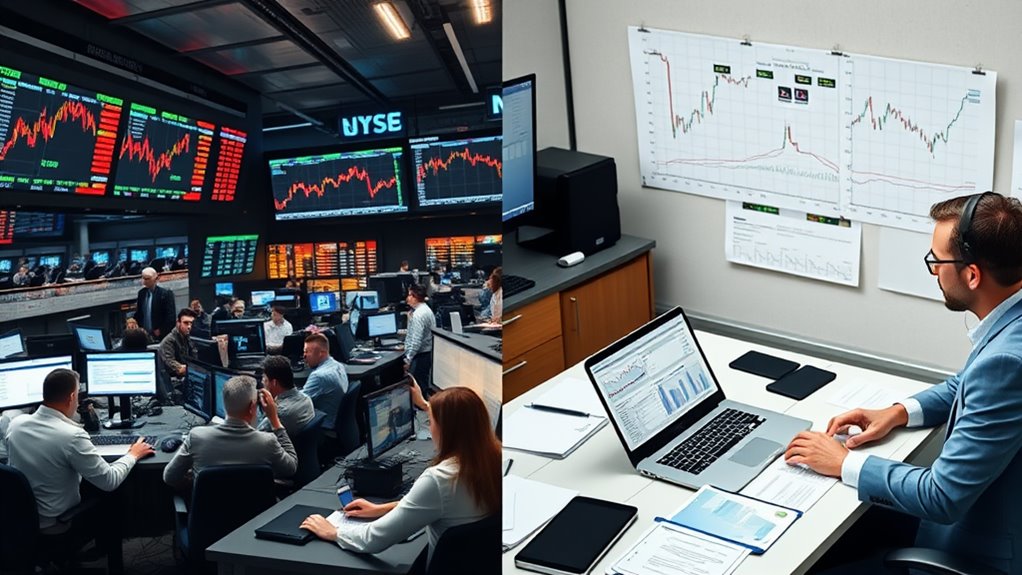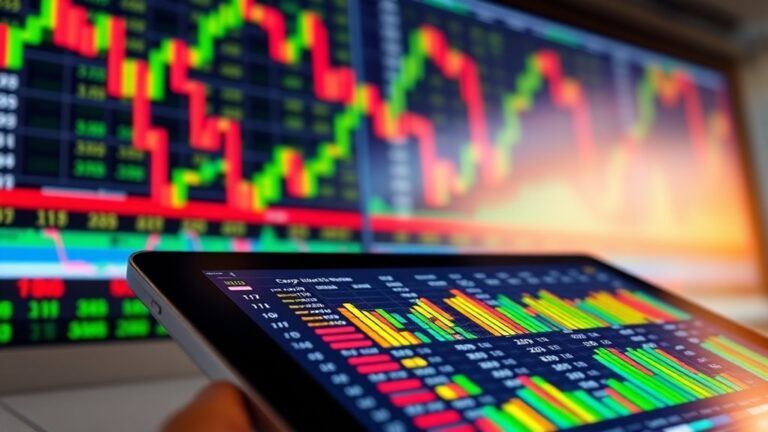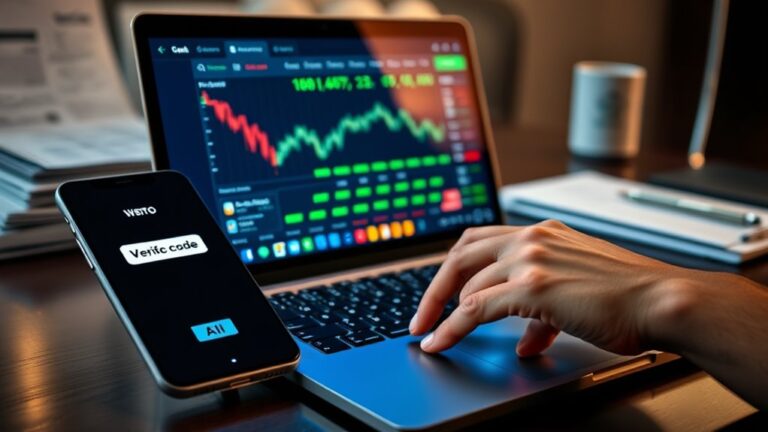
Spot Trading Vs Futures Trading: Which Is Best for Profit?
Spot trading offers lower risk with direct asset ownership, while futures trading provides higher profit potential through leverage and the ability to profit in both market directions. Spot markets feature immediate delivery and transparent pricing, whereas futures enable controlling larger positions with less capital. The best choice depends on individual risk tolerance, with spot suitable for conservative investors and futures appealing to those comfortable with higher risk. The following analysis explores key factors that influence profitability in both markets.
Key Takeaways
- Futures trading offers higher profit potential through leverage, allowing control of larger positions with less capital investment.
- Spot trading presents lower risk with limited leverage exposure but typically generates smaller returns than futures trading.
- Futures traders benefit from favorable 60/40 tax treatment under Section 1256, potentially increasing after-tax profitability.
- Market conditions influence profitability—trending markets favor futures while stable markets may benefit spot traders.
- Risk tolerance should guide your choice—futures provide higher profit potential but carry increased liquidation risks.
Understanding the Core Differences Between Spot and Futures Trading

While both represent considerable trading mechanisms in financial markets, spot trading and futures trading differ fundamentally in their execution, purpose, and underlying principles.
Spot trading involves immediate asset delivery at current market prices, granting traders instant ownership. The process is straightforward, transparent, and reflects real-time market conditions.
Spot trading offers transparency and immediacy—real-time ownership at current market rates.
In contrast, futures trading involves contracts for future delivery without immediate ownership. These contracts enable speculation and hedging, offering high leverage that amplifies potential gains while increasing risks.
Futures markets typically feature higher liquidity but greater complexity, requiring deeper market knowledge.
Capital requirements also differ markedly—spot trading demands full upfront capital, while futures leverage reduces initial costs.
Regulatory frameworks vary between these markets, with futures typically subject to stricter oversight to maintain market integrity.
Risk vs. Reward: Comparing Profit Potential in Both Markets

To understand the financial landscape of trading fully, investors must examine the distinct risk-reward profiles of spot and futures markets.
Spot trading offers straightforward profits from price increases, presenting lower risk with limited leverage exposure. This approach suits beginners seeking stability amid market volatility.
Futures trading, conversely, provides amplified profit potential through leverage in both rising and falling markets. Traders can capitalize on price movements in either direction, potentially generating higher returns than spot trading.
However, this comes with increased risk exposure, including possible liquidation during market downturns.
The choice between these markets ultimately depends on individual risk tolerance, experience level, and investment goals.
While futures offer greater profit potential, spot trading delivers a more balanced risk-reward ratio for risk-averse investors. Additionally, understanding various trading strategies is crucial for making informed decisions in either market.
Leverage: The Double-Edged Sword of Futures Trading

Leverage in futures trading enables investors to control larger positions with less capital, potentially turning modest market movements into significant profits. This financial tool allows traders to amplify their gains far beyond what spot trading typically offers, sometimes achieving 10x or even 100x multipliers on their initial investment. However, this magnifying effect works both ways, creating substantial liquidation risks where adverse price movements can quickly deplete trading accounts, making proper risk management essential for futures traders. Understanding slippage in crypto trading is also vital, as it can impact the execution price and overall profitability of leveraged trades.
Amplified Gains Potential
The allure of increased earning potential draws many traders to futures markets, where the power of leverage transforms modest investments into substantial positions.
Unlike spot trading, which requires full capital upfront, futures trading enables investors to control $100,000 worth of assets with just $10,000 in margin, greatly amplifying potential returns.
This leverage mechanism creates opportunities for traders to capitalize on both rising and falling markets through long and short positions.
When market trends move favorably, the returns can be considerably higher than those possible in spot trading with the same initial capital.
Additionally, the higher liquidity in futures markets guarantees easier execution of trades, allowing for more efficient position management.
However, these amplified gains come with proportionally increased risk, making proper trend identification and risk assessment essential for success. Furthermore, as crypto exchanges adapt to new regulations, they must also navigate the effects of increased scrutiny on trading practices.
Managing Liquidation Risks
Walking the tightrope of futures trading requires careful attention to liquidation risks, which represent the most significant danger for leveraged traders. When positions move against expectations, traders face automatic liquidation if margin requirements aren’t maintained, potentially leading to substantial losses.
| Risk Management Strategy | Benefit | Implementation |
|---|---|---|
| Lower Leverage | Reduces liquidation probability | Use 5x instead of 20x leverage |
| Stop-Loss Orders | Limits potential losses | Set automatic exit points |
| Margin Monitoring | Prevents unexpected liquidations | Maintain at least 50% extra margin |
Effective risk management involves continuously monitoring market volatility and adjusting strategies accordingly. Successful futures traders regularly reassess their leverage based on changing market conditions and maintain sufficient margin to withstand price fluctuations. Diversification across multiple positions can also mitigate the impact of adverse price movements on any single trade. Additionally, understanding trading fees is crucial as they can erode investment returns over time.
Market Liquidity and Its Impact on Profit Margins

Market liquidity, while often overlooked by novice traders, fundamentally shapes the potential profitability of both spot and futures trading strategies. The ease with which assets can be bought or sold directly influences transaction costs and price volatility, affecting bottom-line returns.
Futures markets typically offer enhanced liquidity through standardization and higher trading volumes, making them attractive for speculative positions. However, during volatile periods, both markets can experience liquidity constraints as traders face increased margins and funding pressures.
Standardized futures markets offer superior liquidity, yet both spot and futures trading face constraints during volatility as margin requirements escalate.
These constraints often trigger liquidity spirals where reduced funding leads to decreased market liquidity, further increasing margins. This cycle particularly impacts leveraged futures positions, where margin calls can force liquidations at unfavorable prices. Additionally, understanding the differences between centralized and decentralized exchanges can provide insights into market behavior and liquidity dynamics.
Traders who understand these dynamics can better position themselves to preserve capital during market stress and capitalize on opportunities when liquidity returns.
Strategic Approaches for Maximizing Returns in Each Market

Strategic approaches for maximizing returns in both spot and futures markets hinge on establishing an effective risk-reward balance through techniques like position sizing and stop-loss implementation.
Traders can enhance capital efficiency in spot markets by diversifying across assets, while futures traders typically leverage margin requirements to control larger positions with less capital.
Successful traders adapt their strategies to changing market conditions, employing trend analysis during directional markets and range-trading techniques during consolidation periods. Additionally, understanding the use of limit and market orders can significantly improve trade execution and overall profitability in both trading environments.
Risk-Reward Balance Analysis
When evaluating investment strategies in cryptocurrency markets, traders must carefully weigh the distinct risk-reward profiles of spot and futures trading.
Spot trading offers reduced risk through absence of leverage, direct asset ownership, and simplified management without contractual obligations. This lower-risk approach typically yields proportional returns without amplification.
In contrast, futures trading presents a higher-risk profile due to leverage that magnifies both potential gains and losses. Traders gain access to larger positions with minimal capital but face margin call risks and contract expiration complexities.
The decision ultimately depends on individual factors: investors with lower risk tolerance generally prefer spot trading‘s straightforward approach, while those seeking amplified returns might accept the heightened risks of futures trading, provided they possess sufficient market knowledge and risk management expertise. Additionally, implementing multi-factor authentication can significantly enhance security measures when engaging in either trading strategy.
Capital Efficiency Tactics
Optimizing capital allocation represents a critical dimension for traders maneuvering both spot and futures markets. Each market type offers distinct approaches for maximizing returns while managing risk.
Spot markets provide direct ownership with limited downside, while futures markets offer leverage and hedging capabilities that can amplify efficiency when properly managed.
- Dollar-cost averaging in spot markets reduces timing risks and smooths volatility impacts.
- Margin trading in futures allows control of larger positions with less capital commitment.
- Diversification across multiple spot assets creates natural risk buffers against market swings.
- Strategic hedging with futures contracts protects existing positions without liquidating them.
The ideal capital efficiency strategy often combines elements from both trading types, allowing traders to balance immediate ownership benefits with the speculative opportunities and risk management tools available in futures markets. Additionally, traders should prioritize security features such as two-factor authentication to safeguard their investments across both market types.
Market Condition Adaptations
Successful traders must develop three distinct approaches for traversing spot and futures markets across varying economic conditions. Each market type requires specific strategies to optimize profitability while managing risk exposure.
| Market Condition | Spot Trading Approach | Futures Trading Approach |
|---|---|---|
| High Volatility | Day trading with tight stop-losses | Hedging with opposing positions |
| Stable Markets | Buy-and-hold strategies | Calendar spreads for income |
| Trending Markets | Swing trading following trends | Trend-following with leverage |
| Low Liquidity | Focus on high-volume assets | Utilize longer expiration contracts |
Spot markets offer immediate settlement and greater liquidity but expose traders to real-time price fluctuations without leverage protection. Meanwhile, futures trading provides capital efficiency through leverage and standardized contracts, making it ideal for hedging against price risks. Both require different analytical approaches—spot trading demands constant monitoring of supply-demand dynamics, while futures trading necessitates understanding contract terms and expiration effects. Additionally, traders can benefit from exploring peer-to-peer trading platforms which can offer unique advantages in specific market conditions.
Capital Requirements and Investment Efficiency Analysis

The fundamental difference between spot and futures trading becomes especially apparent when examining capital requirements and investment efficiency. Spot trading demands full upfront payment to purchase assets, providing immediate ownership but limiting position size.
Futures trading, conversely, enables leverage with less initial capital, allowing traders to control larger positions and potentially amplify returns.
- Spot markets require 100% capital allocation, constraining simultaneous positions but offering direct asset control.
- Futures markets permit entry with minimal capital through leverage, though this increases potential losses.
- Transaction costs typically remain lower in spot trading due to simpler fee structures.
- Futures contracts provide flexibility for both long and short positions, expanding strategic opportunities.
These capital requirement differences markedly impact investment efficiency, risk exposure, and ultimately, potential profitability.
Tax Implications and Long-Term Profitability Considerations

Tax structures between spot and futures trading represent a critical differentiating factor that considerably impacts long-term investment returns.
Futures contracts traded on U.S. exchanges fall under Section 1256 of the IRC, receiving favorable 60/40 tax treatment where gains are divided into 60% long-term and 40% short-term capital gains rates. This often results in lower overall tax liability compared to spot trading.
Section 1256’s 60/40 tax treatment for futures trading creates substantial tax advantages unavailable to spot traders.
Spot trading typically follows standard capital gains rules, with taxation varying based on holding period.
Futures traders enjoy additional advantages, including exemption from wash-sale rules, which benefits frequent traders.
For long-term profitability, investors must consider how contract expirations affect investment horizons and how leverage amplifies both gains and losses.
Professional tax advice is essential when developing strategies to optimize tax benefits while managing market volatility.
Frequently Asked Questions
How Do Emotional Factors Affect Decision-Making in Spot Versus Futures Trading?
Emotional factors greatly impact trading decisions differently across markets. Spot trading’s immediate nature and lower leverage often produce less emotional stress, while futures trading’s higher volatility and leverage can amplify fear, greed, and other psychological biases.
Can Algorithmic Trading Systems Perform Differently Between Spot and Futures Markets?
Algorithmic trading systems indeed perform differently across market types. Research confirms that futures algorithms require more complex logic for handling leverage, contract specifics, and future price expectations, while spot systems focus on immediate price action optimization.
How Do Global Economic Events Impact Spot and Futures Markets Differently?
Global economic events affect futures markets through heightened speculation and leveraged positions, causing amplified volatility. Spot markets respond more directly to immediate supply-demand changes, typically exhibiting less dramatic but more immediate price adjustments.
What Role Does Market Sentiment Play in Each Trading Environment?
Market sentiment drives immediate price reactions in spot trading without leverage. In futures trading, sentiment influences expectations for future prices, with leverage amplifying its impact and requiring more sophisticated analysis for risk management.
How Do Broker Selection Criteria Differ for Spot Versus Futures Trading?
Broker selection for spot trading emphasizes platform simplicity and lower capital requirements, while futures trading demands regulatory compliance, advanced market analysis tools, and brokers capable of supporting complex risk management strategies.
Conclusion
Neither spot nor futures trading presents a definitive path to financial success. Each approach offers its own blend of opportunity and challenge, with futures providing enhanced capital efficiency through financial leverage, while spot trading delivers a more measured risk profile. Investors should select their preferred method based on risk tolerance, capital reserves, and temporal horizons—remembering that market participation always carries the possibility of unfavorable outcomes regardless of the chosen vehicle.












